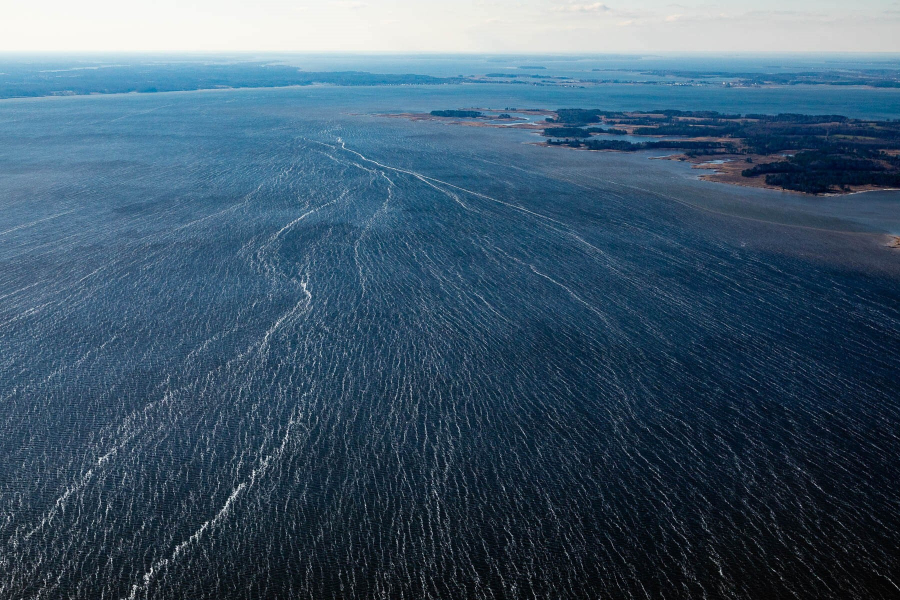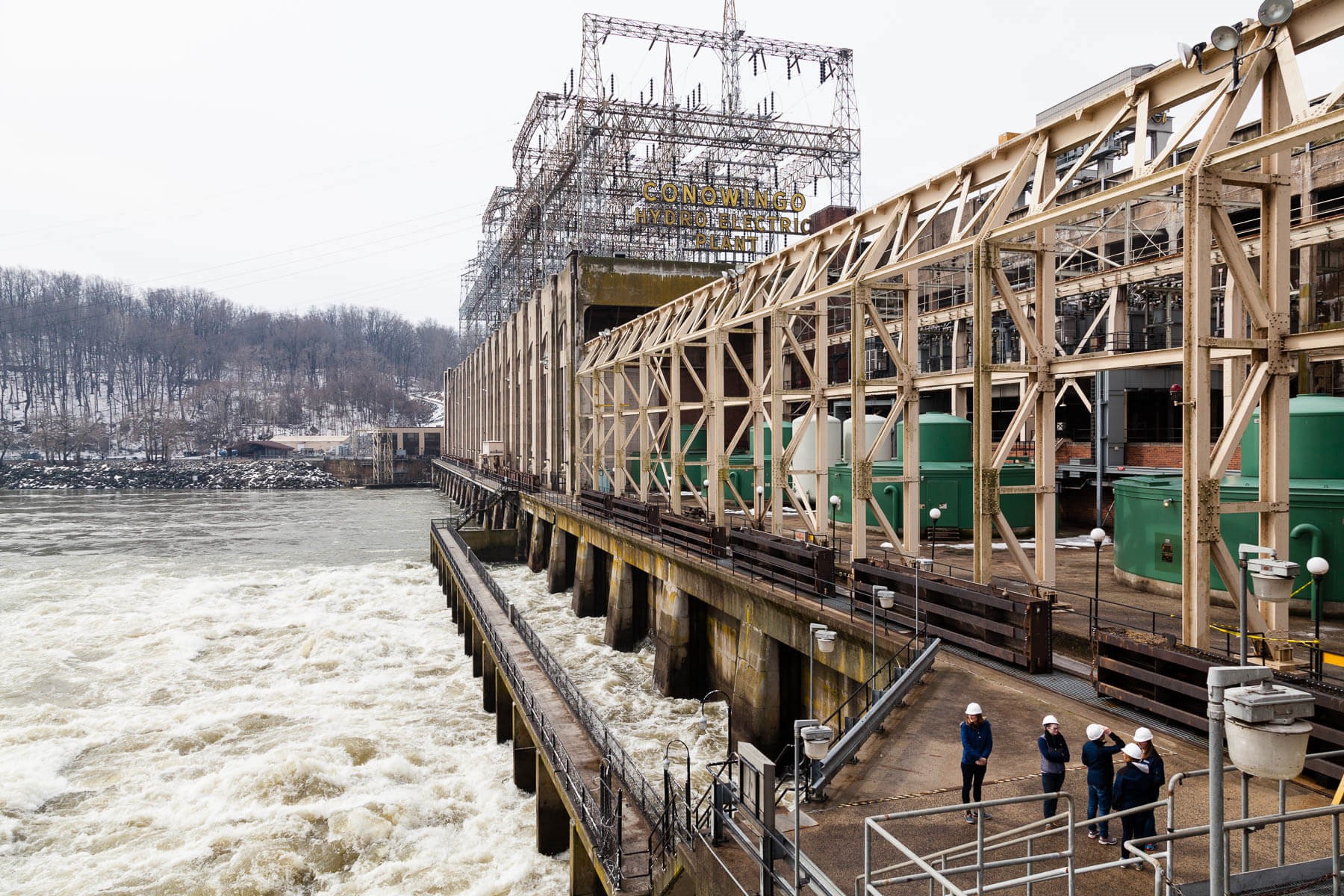Is the Chesapeake Bay fresh or salty?

Have you ever noticed that the air smells salty in some places on the Chesapeake Bay, while in others it does not? The salt you smell has to do with the salinity, or amount of dissolved salt, in the water.
The Chesapeake Bay is an estuary—a partially enclosed body of water where fresh water from rivers and streams mixes with salt water from the ocean. About half of the water in the Bay comes from salt water from the Atlantic Ocean. The other half drains into the Bay from its enormous 64,000-square-mile watershed.
The Chesapeake Bay's salinity is highest at its mouth, where sea water from the Atlantic Ocean enters. On the upper Bay in Maryland, where the Bay's salinity is lowest, you probably won't smell that “ocean” smell. But near the mouth of the Bay in Virginia, where salinity is highest, the air may smell very salty.
Of course, this “salty air” test isn't exactly scientific. Salinity is usually measured in parts per thousand (ppt), the number of grams of dissolved salts present in 1,000 grams of water. Fresh water, like you would find at the head of the Bay and its tidal rivers, contains few salts (less than 0.5 ppt) and is less dense than the ocean-strength salt water at the mouth of the Bay, which averages 25 to 30 ppt.
In addition to the difference in salinity from north to south, the water on the Bay’s Eastern Shore tends to be saltier than water on the western side, due to two factors:
- Most fresh water enters the Bay from its northern and western tributaries, including the Susquehanna and Potomac rivers.
- The Coriolis Force, a phenomenon caused by the earth’s rotation, pushes flowing water in the Northern Hemisphere to the right, so saltier water moving up the Bay veers toward the Eastern Shore.
Most of the water in the Bay, including in the middle portion of the Bay and its tidal rivers, is brackish. Brackish water is a mixture of salty and fresh, with a salinity level of greater than 0.5 ppt but less than 25 ppt.
Salinity varies widely from season to season and from year to year, depending on the amount of fresh water flowing from the Bay’s rivers. The Bay tends to be fresher in spring, when snow melts and heavy rainstorms are frequent. During drier months, the Bay is usually saltier.

Drastic changes in salinity can have severe consequences for the Bay’s underwater life. For example, oysters require salty waters and they can’t move if conditions change. They can close their shells, but only for a short period before they begin to suffer. Underwater grasses can be affected as well, as different species require different salinity ranges. These grasses are also unable to migrate if salinity changes.
Blue crabs and finfish are able to move to different places in the Bay to find the right conditions for survival, but this can impact commercial and recreational fisheries. When record rainfall led to fresher conditions in the Bay in 2018 and 2019, blue crabs stayed in the saltier southern regions far longer than they would in a typical year. This meant that watermen in the upper Bay experienced a poor crabbing season in 2019, despite the 60% increase in the blue crab population that year.
While much of the Bay’s native life struggles to adapt to heightened freshwater flows, the Bay’s invasive species can take advantage of the low-salinity conditions. One such species is the blue catfish, an invasive fish that used the fresh conditions of 2018 and 2019 to spread and establish populations in freshwater tributaries throughout the Bay. “Today, blue catfish are more widely distributed than perhaps ever,” says Peter Tango, monitoring coordinator for the Chesapeake Bay Program.
So, the next time you're by the Bay—whether at the beach, on a boat or in your neighborhood—take a deep breath and enjoy the salty (or not-so-salty) smell of the air. While it may simply be a breeze for you, the amount of salt you smell means a lot to the critters living below the water's surface.
This post is adapted from one written by Alicia Pimental for the Chesapeake Bay Program blog in October 2007.

Comments
This article and it's comments have been very helpful and informative.
There were so-called " Oyster Wars " in the late h and early h centuries. Until the mid-h century, oyster harvesting rivaled the crab industry among Chesapeake watermen, a dwindling breed whose skipjacks and other workboats were supplanted by recreational craft in the latter part of the century. The Chesapeake Bay forms a link in the Intracoastal Waterway, of the bays, sounds and inlets between the off-shore barrier islands and the coastal mainland along the Atlantic coast connecting the Chesapeake and Delaware Canal (linking the Bay to the north and the Delaware River ) with the Albemarle and Chesapeake Canal (linking the Bay, to the south, via the Elizabeth River, by the cities of Norfolk and Portsmouth to the Albemarle Sound and Pamlico Sound in North Carolina and further to the Sea Islands of Georgia). A busy shipping channel (dredged by the U.S. Army Corps of Engineers since the 18) runs the length of the Bay, is an important transit route for large vessels entering or leaving the Port of Baltimore, and further north through the Chesapeake and Delaware Canal to the ports of Wilmington and Philadelphia on the Delaware River .
Very helpful. My reason for researching salinity of the bay at different locations is purely self interest. I may be moving tp Owings Mills and I own an aluminum (?) boat and using it in other than fresh or water of mild salinity will be an issue. I own what you would consider a small boat so this is not a major issue for me. I am just trying identifying potential issues for my boating, I am looking forward to exploring the bay.
This was soooo helpful!! Thank you so much for all your help!
I recently came back from a conference in Baltimore and wondered about this literally the entire time I was there. Short of tasting the water in the harbor, this provided me with EXACTLY what I was looking for!
Thank you.
Hi Jacob,
Great question! The salt in the ocean comes from the land as rain reacts with rock. Carbon dioxide in the air reacts with the water to form carbonic acid, a mild acid that breaks down the rock. Electrically charged particles called ions are formed, and the dissolved ions flow through the water to the oceans. Chloride and sodium, two of the most common ions in the seawater, are "salty." Rivers and streams are continually refreshed with springs and rain, but the ocean collects ions from all the rivers that flow into it and keeps them. As ions build up, the ocean becomes salty.
As more salt flows in, salt is also deposited out. As seawater evaporates, salt content increases. When it becomes oversaturated, the salt is deposited on land to become sedimentary rock. Some salt sinks to the ocean floor in sediment, reacts with lava or clay to be absorbed, or is sprayed up onto the land to be lost as salt deposits. The ocean ecosystem itself extracts some of the salt from the water, with some creatures using them to create their shells or mineral deposits in the ocean.
Together, the salt being lost and the salt flowing in has historically kept the oceans' salinity levels in balance. Intense storms, melting ice and increased rainfall can throw the salinity out of balance, disrupting ocean currents and temperatures.
can you add a section/ an article on where the salinity comes from and how it gets there. Thank you.
i found this very informing.
This was so helpful with my reaserch.
I wish this article was more helpful of where salinity areas are and how it affects some ecosystems. I have been doing a lot of research and this wasn't very helpful then I thought. Also for the young learners who are doing a research like me, fun fact crabs can change gender. WEIRD right!!! Also the bottom of a female crab who hasn't laid eggs have a less pointer bottom.
From everything I have learned about crabs in the bay, crabs grow better in less salty water. But females must migrate south to lay their eggs in saltier water. I have lived at the mouth of the Potomac River for 26 years, and have never seen a sook crab with eggs. I have witnessed plenty of sponge crabs at the mouth of the bay.
Wow this was SUPER helpful!
this article made me do good!
yay
This helped me so much on my research!
Thank you!
Your comment has been received. Before it can be published, the comment will be reviewed by our team to ensure it adheres with our rules of engagement.
Back to recent stories